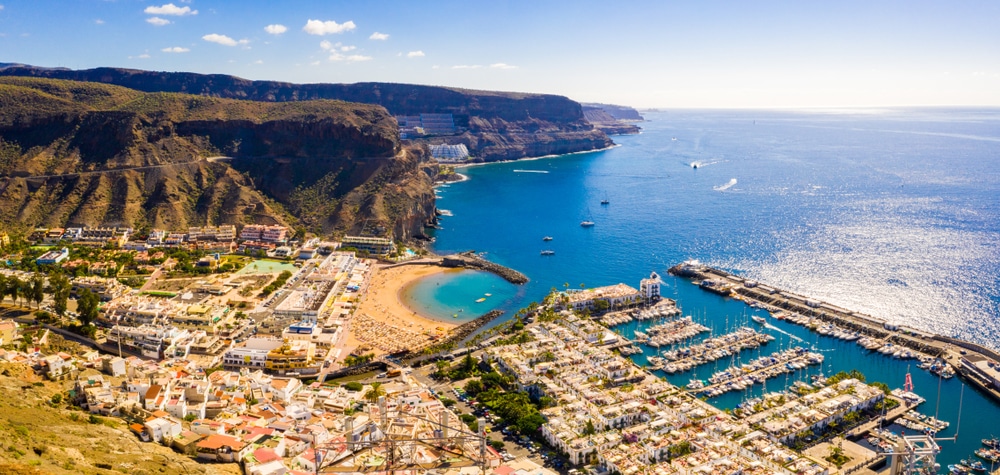In Gran Canaria, every holidaymaker will find the right destination. The selection of places on the island of the Canary Islands ranges from the lively Playa del Ingles to the romantic Puerto de Mogan. Water sports enthusiasts can enjoy diving or surfing, the latter is particularly suitable in San Agustin. Kilometres of sandy beaches and idyllic bays await bathing fans and sun worshippers.
Playa del Ingles
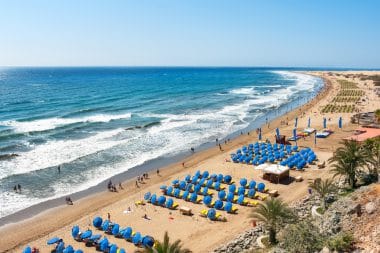
The largest and most famous holiday resort on Gran Canaria is located in the sun-safe south of the island, it impresses with an abundance of hotels and apartment complexes. The kilometre-long sandy beach stretches between Maspalomas and San Agustin and offers numerous beach bars and a large water sports centre. Take a high-speed ride on a jet ski or have fun on a paddle tour. Playa del Ingles has a wide range of shopping and entertainment centres, which offer live music, morning pints and other activities. The restaurants in Playa del Ingles offer Spanish specialties as well as dishes from all over the world, the offer is huge. Above the beach runs the promenade, which is decorated with magnificent plants. While strolling, you can enjoy wonderful views of the Atlantic Ocean as far as the dunes of Maspalomas. Active holidaymakers can go on a mountain bike excursion or have fun with skydiving.
Three kilometres of paradise in the form of a beautiful sandy beach and an impressive sea in the background – this is one of the many reasons why Playa del Ingles of Gran Canaria is still one of the most popular destinations for Germans today. The Spanish island has always been a place of longing for relaxation, for beach holidays and for an escape from the sometimes stressful everyday life. If you decide to travel to the southern part of the island, you will not only have the beaches as a great option for spending your free time.
The Canary Islands Tourism Centre
Of course, the Canary Islands have developed into the hotspot for tourists in recent years. How could it be otherwise – with the sea, the great beaches and last but not least an excellent infrastructure for visitors, there is actually nothing that travelers could lack on the island. While most holidaymakers are primarily drawn to the islands for the beaches, one should not forget that the islands of course also have a certain history and, above all, a special nature. The impressive landscapes created by the volcanoes are worth more than just a trip to the interior of the country.
The advantage of the size of Gran Canaria is, among other things, that you can actually take advantage of all the advantages of Gran Canaria during a stay in Playa del Ingles, as most destinations can be reached in just a few hours by car or even by boat. You can either rely on a rental car or on one of the many guided tours, which are of course also offered by various service providers in the center of Playa del Ingles. So you have a beautiful hotel or holiday home as your own base for excursions and in the morning you can either opt for a relaxing day at the beach or cross one of the many sights on Gran Canaria off your own to-do list.
The special features of Playa del Ingles and its surroundings
Of course, it is above all the sea that knows how to attract visitors. Apart from the beautiful beaches, which are undoubtedly a little more beautiful in this part of the island than in the rest of Gran Canaria, the many small fishing villages and villages in the area beckon. Puerto de Mogán, the Venice of the South, is only a few kilometers away and offers a great atmosphere in a beautiful setting. However, if you prefer to stay in the area of your own hotel, there is a good selection available, especially with the many offers for activities on and under the water.
A boat trip out into the vastness of the sea, for example, offers the opportunity for diving and snorkeling trips. It is not uncommon for these trips to last the whole day and in addition to the necessary equipment and the knowledge of where to find the best areas for an excursion, there is also food. So you can explore the beautiful worlds below sea level and grill fresh fish at sea, in the middle of the Canary Islands sun, and simply enjoy nature a bit.
A visit to the Reserva Natural Especial de Las Dunas de Maspalomas is also a good idea if you have your own accommodation in Playa del Ingles. The nature reserve with its lagoons and unique landscape can be explored either with a targeted tour or on your own, always following the instructions for a stay. The lagoons in particular invite you to further dives or a relaxing afternoon in one of the most beautiful parts of the island of Gran Canaria. From here you can also enter the Paseo Costa Canaria, the famous coastal promenade that connects a large part of the towns of this region and is a small highlight for visitors who want to walk by the sea.
Accommodation and meals when visiting Playa del Ingles
No one has to worry about food on a holiday in Playa del Ingles. Not only do the hotels have great restaurants in different price ranges, but there are also many offers in the towns themselves, ranging from local cuisine to top international chefs. So you can enjoy the freshest seafood here in the evening with a view of the beach or go to one of the taverns and enjoy the good vibes and nightlife that the entire region is known for among visitors while enjoying beer and pizza.
The many different ways to spend your holidays in Playa del Ingles are one reason for the constant stream of new visitors. You can build a holiday according to your own wishes and experience relaxation in various forms or immerse yourself in the culture of Gran Canaria and enjoy the nightlife to the fullest in the evening.
Maspalomas
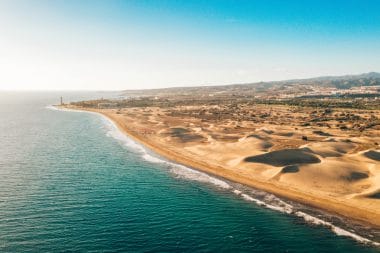
The seemingly endless beach of Maspalomas is directly adjacent to Playa del Ingles – a popular route for beach runners. The end point of this beach hike is the striking lighthouse – Faro de Maspalomas. On the beach, sunbathe against the backdrop of the famous Maspalomas Dunes, which has a desert-like feel and is a protected area. Hobby photographers get their money’s worth here! Between the dunes and the lighthouse stretches the small lagoon of La Charca, which is overgrown with rushes and reeds. Here you can observe various bird species, and the palm grove is an attractive eye-catcher. In the small Center Oasis you will find a good selection of restaurants and beach bars.
Colourful culture
A landmark of Gran Canaria and a tourist zone par excellence, the Maspalomas Lighthouse attracts visitors and residents alike. Located between the dunes and Maspalomas beach, it stretches upwards. Built at the end of the 19th century, the monument has been in continuous operation since February 1, 1890 and radiates for miles from Arinaga in the northeast to Punta de Castillete in the northwest of the island. With a height of 60 meters, it can be seen from afar, which is why tourists often notice it as soon as they arrive in Gran Canaria. However, if you can’t see it in real life, you don’t have to be disappointed. Numerous postcards and photographs immortalize the beautiful lighthouse with its radiance.
The next highlight, Maspalomas, continues in a boozy mood. It is true that it is not part of the typical local culture. Nevertheless, Aqualand Maspalomas attracts numerous tourists every year. The special water park has a variety of pools, slides and other structures, which provide a skilful cooling. Aqualand is particularly visually enchanting with its water attractions, which are based on buildings and areas on the island. The water park is open all year round and offers entertainment for the whole family.
Once a year, Maspalomas hosts a very special party: the Maspalomas Carnival. Although in February the colourful hustle and bustle is celebrated everywhere in the Canary Islands, this festival is a sensation. In the entire San Bartolomé region, which is located in the south of the island, bright colors and cultural diversity line up side by side. Once you have experienced it, you will never want to miss the Carnival of Maspalomas.
Get out into nature
If you want to experience not only the cultural hustle and bustle, but also the nature on Maspalomas, you don’t have to look long for suitable excursion destinations. The dunes of Maspalomas are considered one of the definitive must-sees of the Canary Island. Already several million years old, they were formed by the indispensable influence of the wind. Through this, small, crushed elements were carried ashore over the island and distributed over the entire area. Some observers see strong similarities between the dunes of Maspalomas and a desert, which is surrounded by the sea and a shopping promenade.
If you don’t just want to marvel at the dunes, a camel ride through the area is a good idea. The unforgettable experience lasts around 30 minutes and provides unforgettable insights. Each camel is equipped with a comfortable saddle with two seats, so couples and groups can ride out together without any problems. To ensure that everything is safe and that every adventurer comes home safely, Sahawari guides lead the camel herd. The offer is available directly on site or online. Thus, spontaneous guests can also explore the dunes on the back of a camel. By the way, the offer is not limited to one age group. Children and adults alike can get into the unique feeling of riding a camel.
Back from the camel tour, the exploration tour does not have to end for a long time. The promenade of Maspalomas invites you to linger and take a walk. Some visitors even explore the long route by bike, e-scooter or Segway. The various shops invite you to go shopping or strolling. Especially near the lighthouse there are numerous artists who create sculptures and pictures from sand. It is never possible to say exactly which ones are depicted. For this reason, it is always worthwhile to walk along the promenade, as the works of art can be viewed from it at any time free of charge. However, those who wish can give the artists small donations for their creative achievements.
The inland lake of Maspalomas provides visual cooling. It serves as a marker for Maspalomas beach and is located right next to the famous lighthouse. The combination of dunes and lake gives the impression of an oasis-like landscape that stretches over the horizon. The nature reserve is also considered the most important wetland on the island of Gran Canaria, which makes it of great scientific and tourist importance.
On the road on wheels
Although Maspalomas can be explored largely on foot, each visitor can only experience the full beauty of the area on their own if they venture onto a mobile base. Avid cyclists should try their hand at Parque Urbano del Sur. The e-bike tours lead over the mountains of the Canary Island, which provide unique impressions. Of course, no one is alone on the road. All tours are led by experienced bikers who know all kinds of interesting facts about the nature of the Canary Islands. At the same time, the tours are not driven in one piece. Again and again, short stops are made to get information about the individual sections or sights.
As an alternative to classic cycling, panoramic tours by car are available throughout the area for those interested. The individual routes lead through the center of Gran Canaria, which can be examined in detail. Additional entertaining information will be provided by the guides. In order to be able to admire not only the area from the outside, the individual tours lead through villages rich in history.
Meloneras
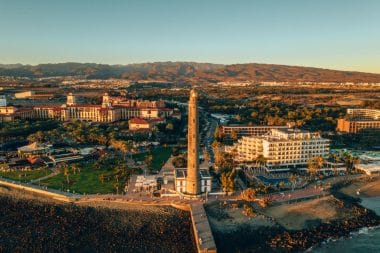
To the west of the lighthouse is the resort town of Meloneras, with luxurious hotels, exclusive restaurants and fine boutiques. The promenade offers beautiful views of the deep blue Atlantic Ocean and the nearby harbour town of Pasito Blanco. At the same time, elegant promenades invite you to stroll. Some hotels present themselves as extraordinary themed hotels in an African ambience or in the style of a Canarian village. Overall, Meloneras looks very high-quality, and this also applies to the brightly designed Varadero shopping center. Jewellers, perfumeries and shops with designer fashion and exquisite gift items have settled here. The promenade runs from the lighthouse to Playa de Meloneras, a small bay in front of the shopping center of the same name, which has some good restaurants and bars.
Meloneras: Between desert landscape, nature reserve and amusement parks
Meloneras is a town located in the very south of the third largest Canary Island, Gran Canaria. Sun worshippers and beach vacationers in particular appreciate Meloneras, because the city’s beach not only offers the best infrastructure, but also a particularly beautiful view of the sea. In the immediate vicinity of Meloneras, there are also other attractions, such as the dune landscape of Maspalomas, which is located in a nature reserve, the small town of the same name, several botanical gardens and amusement parks as well as the archaeological site of the Guanche ruins of Meloneras. Meloneras is therefore an ideal holiday destination for those who want to relax on the beach as well as be active. The hotel offer and also the offer structure of the boutiques and shops in the village are primarily aimed at tourists who want a first-class holiday that they are happy to pay for.
Relax and stroll along the beaches of Meloneras to the Faro de Maspalomas
Meloneras is sometimes referred to as its own holiday home and partly as a district of the nearby town of Maspalomas. Thus, the beach sections of Meloneras and Maspalomas merge into each other. Directly in front of the hotel complexes of Meloneras is Playa Del Faro. The yellow, fine-grained sandy beach invites you to take long walks on the beach, which exude romantic flair, especially in the evening hours. Those who need a break from sunbathing and swimming in the turquoise sea water will find a magnificent seafront promenade just a few steps from the beach, offering restaurants, bars and boutiques with high-quality products. At the end of the beach promenade, it is worth taking a detour to the Maspalomas lighthouse. The Faro de Maspalomas, as the lighthouse is called in the local language, is no less than 60 meters high and can be seen from afar. It was built between 1861 and 1889. In the beginning, the light of the lighthouse was still operated by a beacon device. Electric light has been on in the Faro de Maspalomas since 1906, and since 1973 it has even managed without a lighthouse keeper, because in that year the lighting system was automated.
A feeling like being in the desert: the dunes of Maspalomas
The dunes of Maspalomas are easily accessible on foot from Meloneras. If you want to take a walk on the beach of just over three kilometers, you can get there directly. The sandy dune landscape looks like a small desert that stretches over a length of six kilometers and a total width of two kilometers. The thin ones pile up high in high water in strong winds. 20 meters high are not uncommon here. It is definitely worth climbing the dunes, even if it can be a little sweaty in the heat of the island summer. Because from the top you have a wonderful view over the sea. This excursion can be particularly recommended in the evening hours, because when viewed from a dune, the sunset looks uniquely romantic and colourful. The entire area has been designated as a nature reserve since 1987, where bird lovers also get their money’s worth, as numerous waterfowl breed here.
Visiting the indigenous people of Gran Canaria: The Guanche ruins of Meloneras
The Guanche ruins of Meloneras are located directly above the beach Punta Mujeres. This is where the indigenous people of the Canary Island, known as the Guanches, settled. The Stone Age people first lived in caves on the island, later they also built stone settlements, for example on the beach of Punta Mujeres. Here you can see some old foundation walls of such a settlement, which have been supplemented by an information board that provides information about the Guachian people, their settlement construction and their way of life.
The botanical gardens around Meloneras
If you are enthusiastic about plants, you should definitely visit the Jardin Botanico of Maspalomas. Here, on a huge area of over 12,000 square meters, more than 500 plant species can be seen, which are native to the entire globe. Access is even free. Another beautiful botanical garden is the Parque Tony Gallardo, which is located near the dunes of Maspalomas. The park is well maintained and landscaped. The focus is on native plant species.
The exciting theme parks near Meloneras
Especially those who travel with children or teenagers will appreciate the wide range of amusement parks in the immediate vicinity around Meloneras. The Park Holiday World is mainly tailored to the needs of families with smaller children. The rides are fun but not too spectacular, and there’s an arcade and plenty of takeaways. Bowling can also be played here. Aqualand is a boozy place. Shuttle buses connect this aqua park with the hotel complexes. Once at their destination, water rats whiz down the many water slides. Palmitos Park is the largest theme park nearby and is great for a full day trip. Palmitos Park is primarily a bird and animal park. You can simply look at the animals on your own, or visit the animal shows on offer. For example, there is a bird of prey and a dolphin show. Palmitos Park is easily accessible by public transport buses.
San Agustín – Quiet holiday resort in Gran Canaria
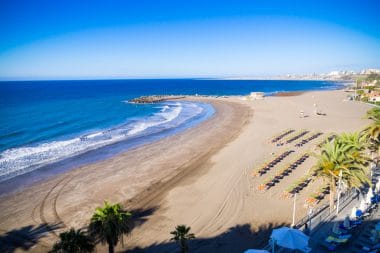
If you want to spend a quiet and relaxing holiday, you should choose San Agustin. The resort is adjacent to Playa del Ingles, so the entertainment venues there are within easy reach. The two beaches Playa de las Burras and Playa de San Agustin provide bathing fun, and both beaches have a promenade that stretches all the way to Playa del Ingles. Playa de las Burras is particularly popular with kitesurfers. San Agustin is characterized by bungalow and apartment complexes, and there are also a few larger hotels. In the San Agustin shopping centre, restaurants, bars and shops promise variety. In the middle of the village runs an attractively designed green area.
For families and for all those who are looking for a quiet place on the popular lively island of Gran Canaria, San Agustin is the right choice.
Located in the south of the island and in the immediate vicinity of the lively beach of Playa del Ingles, San Agustin is something of a tranquil oasis.
The origin of San Agustin
The place has not grown over many years and decades, like the capital Las Palmas or the picture-book town of Puerto Mogan.
The Spanish nobleman Conde de la Vega Grande wanted to profit from the incipient tourism with his large properties in the south of Gran Canaria. Therefore, he participated in the planning of tourist centers. The history of the town of San Agustin began in 1962 with an international architectural competition. Together with the towns of Maspalomas and Playa del Ingles, San Agustin belongs to Costa Canaria and is part of the municipality of San Batholomé de Tirajana.
Character and location of San Agustin
It is 40 kilometres to Las Palmas International Airport in the north-east of the island. With the rental car, the journey time is about 30 minutes. The vast majority of tourists who come here love the tranquility that this place exudes. As if time were stopped, the peaceful atmosphere decelerates. Extensive nightlife, discos, bars and restaurants as in typical Spanish tourist resorts are not to be found here. A shopping street satisfies the desire for shopping experiences.
The dominant theme is the beach of San Agustin.
Beach life in San Agustin
The 600-metre-long beach is 70 metres wide and its sand is slightly darker than that of Playa del Ingles. Gently sloping, it is ideal for swimming for non-swimmers and small children. The water is crystal clear and clean. A children’s playground ensures that there is no boredom away from water and swimming and that little explorers are in good hands. Every now and then a gusty wind disturbs you and then you have to “watch out” with waves and currents. However, on the vast majority of days of the year it is relaxed and safe to swim here. In addition, the beach is supervised by lifeguards. In some places, rocks protrude into the water and serve excellently as breakwaters.
Gliding over the waves with body boarding and surfing on a surfboard is completely relaxed without much tourist hype.
For divers and snorkelers, the underwater world on the rocks is a fascinating experience. A diving school on the beach of San Agustin offers diving courses for beginners and beginners.
The kilometre-long promenade stretches above the sea along individual bays to Playa del Ingles and is an excellent walking path.
Active holidays in San Agustín
If you are drawn away from the water from time to time, you have the opportunity to explore a wonderful hiking trail. In about two hours, it leads above the coast to the Maspalomas lighthouse. It is considered the landmark of Gran Canaria and from there it is a magnificent view of the wide beach, the sea and the endless dune landscape.
The hiking trail to the waterfalls in the wild Barranco del Toro is more difficult. The strenuous scramble through gorges and wild undergrowth is then rewarded with an unimaginable backdrop.
For those who prefer it more relaxed, the Spa and Thalasso Centre is recommended. One of the largest facilities in Europe is located very close to San Agustin and pampers its guests on 7000 square meters with various algae and mud therapies, with sauna and massages, with various pools and hydromassage and underwater jets.
Attractions around San Agustin
For children and adults alike, the Wild West theme park Sioux City is exciting. There is a bank robbery, Indian shows or Mexican dances to experience. In the Aqualand amusement park near Maspalomas , daredevils dare to take on the “Crazy Race Slide” or paddle on the Congo River with giant floats. Palmitos Park in the south of Gran Canaria is a destination for the whole family. Exotic birds and crocodiles are the main attractions.
Our excursion tip in the south of Gran Canaria: the indescribably picturesque, romantic town of Puerto de Mogán. Around the marina and fishing port, houses and streets, bridges and courtyards are a blooming paradise full of bougainvillea, palm trees and strelizia.
Puerto de Mogán

Puerto de Mogan is a small port and was built around the fishing village of Mogán. Small canals lead from the village to the harbour. The city is known as “Little Venice” or “Venice of the South”.
The holiday resort of Puerto de Mogan in the southwest of Gran Canaria exudes a romantic flair. Narrow streets are spread around the harbour, the arches of which are decorated with wonderfully flowering plants. The small bay is lined with cafés and restaurants. A promenade runs around the entire port, which consists of a marina and fishing port. Here you can marvel at yachts from all over the world and watch the fishermen at work. At the back of the harbour, glass-bottom boats and a submarine depart so that you can marvel at the species-rich underwater world of the Atlantic. Underwater sports enthusiasts can use the services of a diving school to explore the best dive sites in the region.
The settlement was only laid out in the 1980s. The aim was that the place should never lose its original appearance, as it is part of the cultural heritage of Gran Canaria. New houses must therefore not be built higher than the existing ones. The white and blue houses with the numerous flowers make a very picturesque picture.
What is the great attraction of Puerto de Mogán?
Since the multi-storey shopping centres and hotel complexes were built a few kilometres away, the charm of the small fishing village was preserved. The harbour itself was artificially created and also offers a marina with a shipyard for boat repairs. Ferries operated by the Blue Bird and Lineas Salmón shipping companies guarantee that you can visit other islands during your holiday. The breathtaking underwater world can be explored by submersible. In addition to fast food and Central European dishes, each restaurant offers fish specialties. An artificial beach offers variety for the whole family. The beach is very shallow and therefore excellent for children. The beach is beautiful and is also visited by the locals on weekends. With a yellow submarine, a 40-minute exploration trip to a sunken wreck can be undertaken. The trip costs 29 euros, children pay only half. Sekayak is a special experience for young and old. Pedal boats can also be rented at any time.
The bus service from the neighboring tourist centers also leads to the settlement. In front of the hotel at the harbour including the apartment complex, there is a weekly market every Friday, where regional products and products are offered. Numerous stone benches invite you to linger. In one of these squares is the sculpture of the fruit vendor Elias Hernández Garcia, who is still revered today as an original of the place. Although Puerto de Mogán is a small town, there is a direct motorway connection to Las Palmas. The island expressway leads up to the village. From the next larger valley in La Aldea de San Nicolás and Agaete, there is a breathtaking view of the Atlantic. On nice days, you can even see the island of Tenerife or the Pico de Teide volcano.
What is the attraction for the locals?
The main reason is probably that Puerto de Mogan looks like one of the most famous tourist centers in the world, Venice. In addition, the Canarios love their water canals and small picturesque fishermen’s cottages. The villagescape is characterized by flowers and cheerful people. There are still a few fishermen who supply the newly established small restaurants with fresh fish.
Which ferries are there?
From Puerto de Mogan for a ferry to Puerto Rico, Anfi or Arguineguin. The journeys take between 30 minutes and 60 minutes. The place is also popular with other vacationers from Playa del Inglés or Maspalomas. Of course, rental cars are also a way to get around the island.
What is the Mirador?
This is a path that leads from the center of the village, through small alleys with numerous stairs up to the highest point with a breathtaking view. The Mirador is labeled with blue signs, so there is no getting lost.
The other side of fishing
For decades, fishing was the main source of income for the people of Puerto de Mogan. Since tourism has been booming, more and more fishermen have opened small restaurants and shops or rent boats to tourists. In the harbour you can even rent a boat for deep-sea fishing. The blue marlin is one of the most famous fish in the area, but it is an endangered species.
The best restaurants in town
The Puerto Grill is an excellent fish restaurant. Taberna Mar Azul is known for its delicious seafood, and Gelatomania is an ice cream parlor that children love. Of course, there is also a pizzeria and plenty of opportunities to try Mediterranean food.
In the Canary Islands, it is customary to end the meal with a dessert. This is the famous semolina pudding with a little cream and chocolate. The islanders love garlic and plenty. Barbecue skewers with fish, meat or lamb are in great demand, especially on holidays or festive occasions. Gofio is an old type of grain from the area and is used for the traditional puree.
Puerto Rico
This resort is located south of Puerto de Mogan and extends into a wide bay with its beautiful sandy beach. Many hotels are built on the slope and offer their guests wonderful views of the sea. Puerto Rico has made a name for itself as the island’s water sports center. Whether sailing, surfing, parasailing or paddling, nothing is left to be desired here. A special experience is a dolphin watching tour. A special adventure awaits hobby anglers, they can start deep sea fishing in Puerto Rico. For the evening, a visit to one of the numerous restaurants on the beach or harbour is a good idea.


